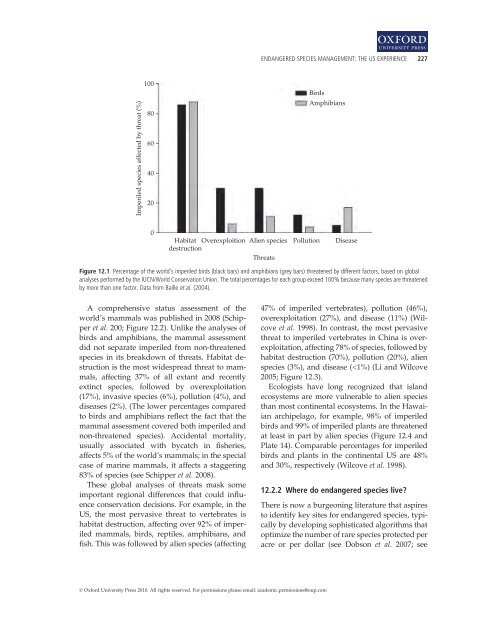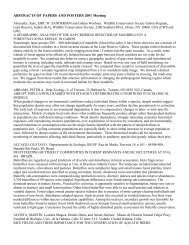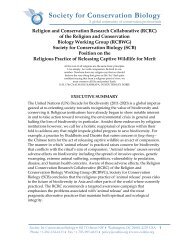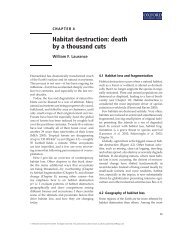Endangered species management: the US experience - Society for ...
Endangered species management: the US experience - Society for ...
Endangered species management: the US experience - Society for ...
Create successful ePaper yourself
Turn your PDF publications into a flip-book with our unique Google optimized e-Paper software.
1<br />
ENDANGERED SPECIES MANAGEMENT: THE <strong>US</strong> EXPERIENCE 227<br />
Imperiled <strong>species</strong> affected by threat (%)<br />
100<br />
80<br />
60<br />
40<br />
20<br />
Birds<br />
Amphibians<br />
0<br />
Habitat Overexploition Alien <strong>species</strong><br />
destruction<br />
Threats<br />
Pollution<br />
Disease<br />
Figure 12.1 Percentage of <strong>the</strong> world’s imperiled birds (black bars) and amphibians (grey bars) threatened by different factors, based on global<br />
analyses per<strong>for</strong>med by <strong>the</strong> IUCN/World Conservation Union. The total percentages <strong>for</strong> each group exceed 100% because many <strong>species</strong> are threatened<br />
by more than one factor. Data from Baille et al. (2004).<br />
A comprehensive status assessment of <strong>the</strong><br />
world’s mammals was published in 2008 (Schipper<br />
et al. 200; Figure 12.2). Unlike <strong>the</strong> analyses of<br />
birds and amphibians, <strong>the</strong> mammal assessment<br />
did not separate imperiled from non-threatened<br />
<strong>species</strong> in its breakdown of threats. Habitat destruction<br />
is <strong>the</strong> most widespread threat to mammals,<br />
affecting 37% of all extant and recently<br />
extinct <strong>species</strong>, followed by overexploitation<br />
(17%), invasive <strong>species</strong> (6%), pollution (4%), and<br />
diseases (2%). (The lower percentages compared<br />
to birds and amphibians reflect <strong>the</strong> fact that <strong>the</strong><br />
mammal assessment covered both imperiled and<br />
non-threatened <strong>species</strong>). Accidental mortality,<br />
usually associated with bycatch in fisheries,<br />
affects 5% of <strong>the</strong> world’s mammals; in <strong>the</strong> special<br />
case of marine mammals, it affects a staggering<br />
83% of <strong>species</strong> (see Schipper et al. 2008).<br />
These global analyses of threats mask some<br />
important regional differences that could influence<br />
conservation decisions. For example, in <strong>the</strong><br />
<strong>US</strong>, <strong>the</strong> most pervasive threat to vertebrates is<br />
habitat destruction, affecting over 92% of imperiled<br />
mammals, birds, reptiles, amphibians, and<br />
fish. This was followed by alien <strong>species</strong> (affecting<br />
47% of imperiled vertebrates), pollution (46%),<br />
overexploitation (27%), and disease (11%) (Wilcove<br />
et al. 1998). In contrast, <strong>the</strong> most pervasive<br />
threat to imperiled vertebrates in China is overexploitation,<br />
affecting 78% of <strong>species</strong>, followed by<br />
habitat destruction (70%), pollution (20%), alien<br />
<strong>species</strong> (3%), and disease (






